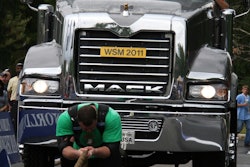If you haven’t been able to tune into the meeting today of the FMCSA’s Motor Carrier Safety Advisory Committee with the Medical Review Board, keep an eye on my Twitter feed at https://twitter.com/channel19todd, where I’m posting various items from the presentations ongoing.
Benjamin Hoffman, director of the Medical Review Board and GE Chief Medical Officer, says he hopes the meeting will result in promulgation of clearcut regulations or guidance relative to drivers and sleep apnea, and DOT Secretary Ray LaHood, in opening remarks, described the meeting as “historic.”
Medical experts this morning have been making a case for the correlation between drivers with moderate to severe sleep apnea and increased crash risk.
Responding to the first of the presenters, Stephen Tregear of the Manila Consulting Group, who’s long worked on evidence analysis for FMCSA, OOIDA’s Todd Spencer noted the seeming wide prevalence of risk factors for apnea among commercial drivers. “If these staggering numbers have some real live applications,” he asked, “why don’t highways all over America look like war zones today.”
Charles A. Czeisler, director of Harvard Medical’s Division of Sleep Medicine, argued in the following presentation that “it is actually a war zone out there.” He cited statistics for all drivers — not just truckers — showing that 20 percent of all crashes are related to drowsy driving, with 2 million drivers a week in the U.S. nodding off and fall asleep at the wheel. With fatalities related to drowsy driving occuring once ever 70 minutes, “that’s equivalent to two 9/11 events every year,” he said.
Czeisler was a member of the 2008 Medical Expert Panel that became the basis for the screening and treatment recommendations we’ve become familiar with re: sleep apnea — BMI of 33 or more as a screening factor for drivers, for instance. None of these have been acted upon as yet in a clear regulatory guidance by FMCSA.
Czeisler, for his part, is recommending getting behind a lower BMI, 30, as a screening requirement, and would require drivers with moderate to severe apnea to be disqualified from driving until being treated and proving that treatment is working.
How all this will play out will depend on the work the committee puts into drafting a task report this afternoon, 1:30-4 p.m. EST, with public comment following from 4-5 p.m. To keep an eye on it, register to view the webinar and log in via this page. Keep an eye on Overdriveonline.com for the report on the remainder of the meeting tomorrow morning — likewise this blog throughout the day, where I will post more if there’s time.











